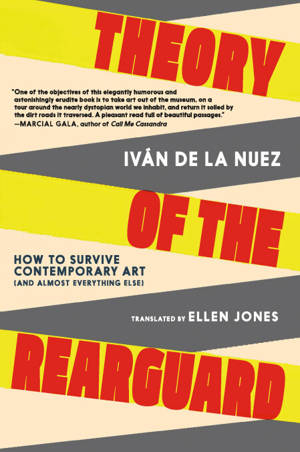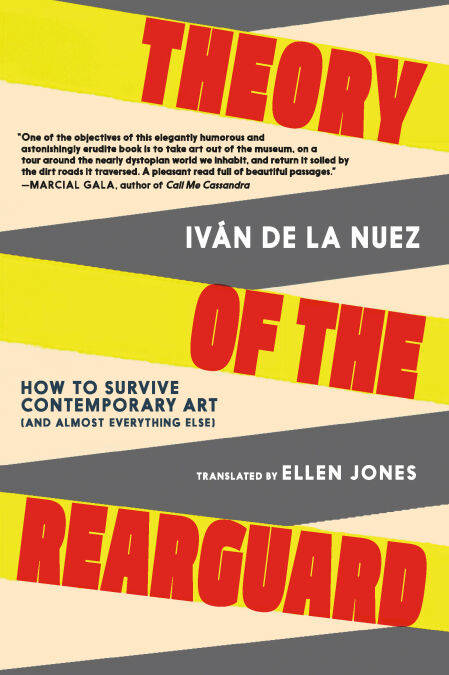
Je cadeautjes zeker op tijd in huis hebben voor de feestdagen? Kom langs in onze winkels en vind het perfecte geschenk!
- Afhalen na 1 uur in een winkel met voorraad
- Gratis thuislevering in België vanaf € 30
- Ruim aanbod met 7 miljoen producten
Je cadeautjes zeker op tijd in huis hebben voor de feestdagen? Kom langs in onze winkels en vind het perfecte geschenk!
- Afhalen na 1 uur in een winkel met voorraad
- Gratis thuislevering in België vanaf € 30
- Ruim aanbod met 7 miljoen producten
Zoeken
Theory of the Rearguard E-BOOK
How to Survive Contemporary Art (and Almost Everything Else)
Iván de La Nuez
E-book | Engels
€ 9,85
+ 9 punten
Omschrijving
Cuban art critic and curator Iván de la Nuez returns with an ironic epitaph for contemporary art.
Art criticism that examines contemporary art in the 21st century in relationship to politics, iconography, and literature.
“Iván de la Nuez transforms art criticism into an art form.” —Letras Libres
Theory of the Rearguard examines how contemporary art is in tension with survival, rather than in relation to life. In the twentieth century, Peter Bürger’s Theory of the Avant-Garde was a cult book focused on the two main tasks that art demanded at the time: to break its representation and to destroy the barrier that separated it from life.
Forty years later, The Theory of the Rearguard is an ironic manifesto about contemporary art and its failures, even though Iván de la Nuez does not waste his time mourning it or disguising it. He argues that our times are not characterized by the distance between art and life, but by a tension between art and survival, which is the continuation of life by any means necessary.
In the twenty-first century, Iván de la Nuez examines art in relationship to politics, iconography, and literature. This austere and sharp book—in which Duchamp stumbles upon Lupe, the revolution upon the museum, Paul Virilio upon Joan Fontcuberta or Fukuyama upon Michael Jackson—wonders if contemporary art will ever end. Because if it were mortal—“just as mortal as everything it invokes or examines under its magnifying glass”—de la Nuez argues would be worth writing an epitaph for it as he has done in this sparkling book of art criticism.
Art criticism that examines contemporary art in the 21st century in relationship to politics, iconography, and literature.
“Iván de la Nuez transforms art criticism into an art form.” —Letras Libres
Theory of the Rearguard examines how contemporary art is in tension with survival, rather than in relation to life. In the twentieth century, Peter Bürger’s Theory of the Avant-Garde was a cult book focused on the two main tasks that art demanded at the time: to break its representation and to destroy the barrier that separated it from life.
Forty years later, The Theory of the Rearguard is an ironic manifesto about contemporary art and its failures, even though Iván de la Nuez does not waste his time mourning it or disguising it. He argues that our times are not characterized by the distance between art and life, but by a tension between art and survival, which is the continuation of life by any means necessary.
In the twenty-first century, Iván de la Nuez examines art in relationship to politics, iconography, and literature. This austere and sharp book—in which Duchamp stumbles upon Lupe, the revolution upon the museum, Paul Virilio upon Joan Fontcuberta or Fukuyama upon Michael Jackson—wonders if contemporary art will ever end. Because if it were mortal—“just as mortal as everything it invokes or examines under its magnifying glass”—de la Nuez argues would be worth writing an epitaph for it as he has done in this sparkling book of art criticism.
Specificaties
Betrokkenen
- Auteur(s):
- Vertaler(s):
- Uitgeverij:
Inhoud
- Aantal bladzijden:
- 96
- Taal:
- Engels
Eigenschappen
- Productcode (EAN):
- 9781644214626
- Verschijningsdatum:
- 21/04/2025
- Uitvoering:
- E-book
- Beveiligd met:
- Adobe DRM
- Formaat:
- ePub

Alleen bij Standaard Boekhandel
+ 9 punten op je klantenkaart van Standaard Boekhandel
Beoordelingen
We publiceren alleen reviews die voldoen aan de voorwaarden voor reviews. Bekijk onze voorwaarden voor reviews.









